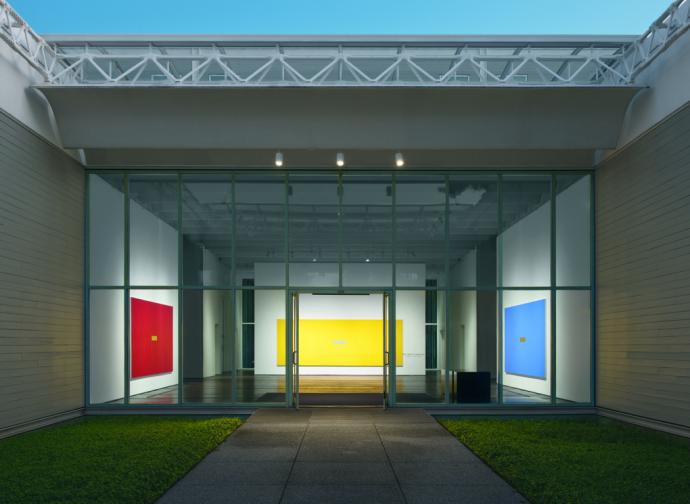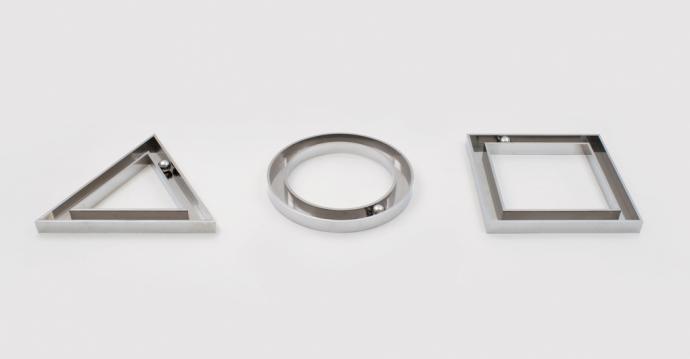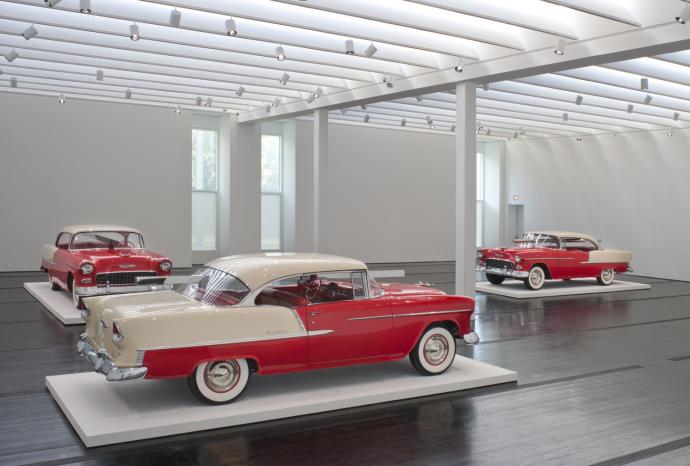from pastelegram.org, June 2011 – April 2014
Walter De Maria: Trilogies
At first glance, the Menil’s exhibition by Walter De Maria contains three trilogies. There are three paintings in each of the primary colors, three stainless steel channels in the shape of a circle, square, and triangle, and three restored 1955 Chevy Bel Airs with twelve-foot steel rods through their windshields, each rod having the profile of a circle, square, and triangle.
However, the artworks’ various time periods complicate this seemingly direct trilogy of trilogies. The exhibition’s collection of works from 1966-1972 appears alongside new works from 2000-2011. The older works are from the Menil’s permanent collection: The Color Men Choose When They Attack the Earth (1968) and Channel Series (1972).1 Each of these subtly plays off the initial static reading of the trilogies and allows for a richer understanding of the idea of the trilogy itself.

The Statement Series contains The Color Men Choose When They Attack the Earth, now called Yellow Painting, plus two new works: Red Painting and Blue Painting (both 2011). Like the 1968 painting, the new works consist of a rectangular canvas painted entirely in one of the three titular primary colors. At the center of each canvas is a stainless steel plaque with a single unique phrase engraved in the middle. Yellow Painting has its former title, Red Painting says “NO WAR NO,” and Blue Painting says “YES PEACE YES.” Together these paintings are about the idea of primary colors, more than the meanings of their individual hues. Combined with red and blue, Yellow Painting isn’t about yellow—or yellow’s references to gold, the sun or whatever—it’s a node in a conceptual triangle.
Yet the plaque on Yellow Painting looks worn. It warps slightly and its connections to the canvas as well as its matte finish are rougher than those of the newer paintings, making the older painting obvious among the three. Its evident age allows one to imagine the canvas as it once was, alone, without Blue Painting or Red Painting. Yellow Painting’s older life is apparent, as are the possibilities of other meanings beyond the idea of primary color implied by the trio of paintings as they stand in the Menil in 2011.
Trilogies have this effect on ideas. They allow for the idea of the things together to trump the things individually. One yellow canvas means a yellow canvas: the thing itself or the possible symbolism of its color. A yellow canvas and a red canvas imply a dialectical relationship where one thinks of orange, or of ketchup and mustard, or whatever, but still something related to the two things themselves. A grouping of three things, however, indicates a different order of abstraction, that of intellectual categories and constructs such as color or shape, within which the initial things occur. The trilogy subsumes its elements within its clearly articulated structure and the connections between each element render more clearly than their individual details.

In this light, Channel Series is about shape just as The Statement Series is about color. For the 1972 trilogy, stainless steel channels perfectly form the shape of a square, a circle and a triangle on a single low pedestal. Yet a loose steel ball runs through all three channel loops—its rolling around over the past forty years has left grooves in the channels and dings on the walls—challenging the intellectualizing of the sculptures as just shapes. The shapes have a past in which each sculpture acquires individual incident and more specific meanings, less about shape in general than the specific meanings brought by use over time.
If Channel Series holds onto its specificity, it only halfway moves toward the more abstract concepts that trilogies tend to imply. However, these lessons about specificity and abstraction only help to frame the show's centerpiece: Bel Air Trilogy (2000-2011).
In Bel Air Trilogy three 1955 Chevrolet Bel Air automobiles with immaculate classic two-tone paint jobs each contain a twelve-foot stainless steel rod passing through both the front and rear windshields. Each of the three rods is different in cross-section; one is square, one circular and one triangular, and each passes through a precisely shaped opening in the car’s glass.
De Maria perfected the cars. All extraneous elements—such as windshield wipers, rear and side mirrors, exhaust pipes, antennas, and license plate frames—are gone. The wheels all have their air valves at top dead center. Where necessary, particularly in the triangle rod Bel Air, 2x4 blocks and straps in the wheel wells (visible from under the car) perfectly level the car’s frame to the ground. The underside frames show visible signs of straightening due to previous wrecks; the Bel Air with a square rod was in a head-on accident at some point.

The stainless steel rods are perfect instead of “perfected,” in contrast to the Bel Airs. Where the Bel Airs’ pristine restoration implies a once-unfinished state, the rods seem foreign and free of the past, stainless steel inserted like alien probes through the cars. Contrasting while yet recalling the Channel Series, the rods could not be more perfect and unearthly.
Just as Channel Series and Yellow Painting wear their age—particularly when juxtaposed with the exhibition’s newer works—so too does the Bel Air Trilogy become about things old that were once new versus things rendered as if they have no past at all. All three trilogies together make such meanings particularly apparent; despite differences of medium and scale, the similarities between each series rise to the surface. Thus the exhibition ultimately concerns how trilogies shape meaning. In the end, we learn not of color or shape, but rather of how combining things into groups of three is the simplest way to transcend the things themselves, even if, and especially because, the individual trilogies failed to do so.
- 1. Technically, Channel Series is composed of three works: Circle, Square, and Triangle. Also, a third older work, High Energy Bar, is located in the hall outside of the show's main gallery, seeming as an afterthought to the main show.